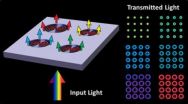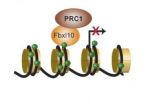(Press-News.org) Tumourigenesis is driven by genetic alterations and by changes in the epigenome, for instance by the addition of methyl groups to cytosine bases in the DNA. A deeper understanding of the interaction between the genetic and epigenetic mechanisms is critical for the selection of tumour biomarkers and for the future development of therapies. Human tumour specimens and cell lines however contain a plethora of genetic and epigenetic changes, which complicate data analysis. In contrast, certain mouse tumour models contain only a single genetic mutation and allow the analysis of nascent tumours. Scientists of the Max Planck Institute for Molecular Genetics in Berlin have now discovered a recurring pattern of more than 13,000 epigenetic alterations in young tumours of the mouse. This genome-wide pattern was found to be partly conserved in human colon carcinoma, and may therefor facilitate the identification of novel clinical colon cancer biomarkers for early detection.
Two kinds of molecular changes are known to trigger tumour development: one is genetic mutations – i.e. alterations in the alphabetic sequence of the DNA –activating genes that lead to uncontrolled growth of tumours, or inactivating genes that inhibit this growth. The other is epigenetic modifications, for example new distributions of methyl groups in the DNA that contribute to the genetic information in the cancer cells being interpreted differently.
Genetic and epigenetic mechanisms work together in cancer development – but little was known about how these systems mutually influence one another, and which changes first come to light. These questions can only be answered with great difficulty through investigating human tumours: the cancer is usually already several years old when diagnosed. Accordingly, the cancer cells already exhibit thousands of genetic and epigenetic changes at this stage, which complicates the analysis.
The matter is different for the corresponding polyps in mice, which the researchers can investigate considerably earlier following their formation. For this reason, scientists of the Max Planck Institute for Molecular Genetics have now pursued the question of which epigenetic changes in intestinal tumours occur first with the help of a mouse model.
"With mice, we can investigate the first changes much more easily than with humans", says Markus Morkel, who led the study. The scientists analysed the epigenetic changes in a strain of mice with a defective copy of the APC gene. This gene serves as an intestinal tumour suppressor in mice as well as in humans. Accordingly, it has lost its functionality in a majority of patients with colon cancer.
The results displayed a clear picture:The researchers recognised a recurring pattern of more than 13,000 epigenetic changes in all of the mouse tumour samples. By contrast, they did not find this pattern in healthy intestine or in intestinal stem cells, which are the cells of origin of the tumour. Since the mice –and hence the tumours– were less than three months old, the changes must have already spread shortly after the first genetic mutation in the APC gene within the tumour cells. According to the scientists, the first mutation already leads to pathological activation of numerous enzymes controlling the epigenetic mechanisms.
Remarkably, the molecular biologists discovered large parts of the tumour-specific epigenetic pattern not only in the mouse, but also in human colon cancer tissue. "These initial epigenetic changes could therefore serve as markers and significantly simplify the early diagnosis of colon tumours in the future", hopes Markus Morkel. Patients would merely have to provide a blood sample for the diagnosis and could forego an enteroscopic procedure.
INFORMATION:
Original publication:
Christina Grimm, Lukas Chavez, Mireia Vilardell, Alexandra L. Farrall, Sascha Tierling, Julia W. Böhm, Phillip Grote, Matthias Lienhard, Jörn Dietrich, Bernd Timmermann, Jörn Walter, Michal R. Schweiger, Hans Lehrach, Ralf Herwig, Bernhard G. Herrmann & Markus Morkel
DNA-methylome analysis of mouse intestinal adenoma identifies a tumour-specific signature that is partly conserved in human colon cancer
PLOS Genetics
Colon cancer exhibits a corresponding epigenetic pattern in mice and humans
Epigenetic investigation of mice can as a result contribute to early diagnosis of cancer in humans
2013-02-08
ELSE PRESS RELEASES FROM THIS DATE:
Study identifies liver gene that regulates cholesterol and fat blood levels
2013-02-08
Researchers have identified a microRNA liver gene, miR-27b, which regulates lipid (cholesterol or fat) levels in the blood. This regulator gene controls multiple genes involved in dyslipidemia—abnormal blood cholesterol levels that can contribute to heart disease. Study details published in the February issue of Hepatology, a journal of the American Association for the Study of Liver Diseases (AASLD), describe a new in silico approach to identify the significance of microRNAs in regulating disease-related gene pathways.
The Human Genome Project (HGP) was completed in ...
Boston College researchers' unique nanostructure produces novel 'plasmonic halos'
2013-02-08
CHESTNUT HILL, MA (February 7, 2013) – Using the geometric and material properties of a unique nanostructure, Boston College researchers have uncovered a novel photonic effect where surface plasmons interact with light to form "plasmonic halos" of selectable output color. The findings appear in the journal Nano Letters.
The novel nanostructure proved capable of manipulating electron waves known as surface plasmon polaritons, or SPPs, which were discovered in the 1950s but of late have garnered the attention of scientists for their potential applications in fields that ...
Specific warning signs of complications in colorectal surgical patients released
2013-02-08
Chicago (February 7, 2013): Colorectal surgical patients are often discharged from the hospital with vague guidance on how to recognize complications, but researchers at the Michael DeBakey Veterans Administration (VA) Medical Center and Baylor College of Medicine, Houston, aim to change that scenario. A health services research team convened a panel of surgical experts to develop a list of postoperative complication signs that should prompt colorectal surgical patients to call their surgeons or go to an emergency room. The study on the development of this early patient-centered ...
Dickkopf makes fountain of youth in the brain run dry
2013-02-08
The hippocampus – a structure of the brain whose shape resembles that of a seahorse – is also called the "gateway" to memory. This is where information is stored and retrieved. Its performance relies on new neurons being continually formed in the hippocampus over the entire lifetime. "However, in old age, production of new neurons dramatically decreases. This is considered to be among the causes of declining memory and learning ability", Prof. Dr. Ana Martin-Villalba, a neuroscientist, explains.
Martin-Villalba, who heads a research department at the German Cancer Research ...
Scientists find key to growth of 'bad' bacteria in inflammatory bowel disease
2013-02-08
(SACRAMENTO, Calif.) — Scientists have long puzzled over why "bad" bacteria such as E. coli can thrive in the guts of those with inflammatory bowel disease (IBD), causing serious diarrhea. Now UC Davis researchers have discovered the answer—one that may be the first step toward finding new and better treatments for IBD.
The researchers discovered a biological mechanism by which harmful bacteria grow, edge out beneficial bacteria and damage the gut in IBD. This new understanding, published in the Feb. 8 issue of Science, may help researchers develop new treatments for ...
Experimental gene therapy treatment for Duchenne muscular dystrophy offers hope for youngster
2013-02-08
Jacob Rutt is a bright 11-year-old who likes to draw detailed maps in his spare time. But the budding geographer has a hard time with physical skills most children take for granted -- running and climbing trees are beyond him, and even walking can be difficult. He was diagnosed with a form of muscular dystrophy known as Duchenne when he was two years old.
The disease affects about 1 in 3,500 newborns -- mostly boys -- worldwide. It usually becomes apparent in early childhood, as weakened skeletal muscles cause delays in milestones such as sitting and walking. Children ...
Protein paves the way for correct stem cell differentiation
2013-02-08
A single embryonic stem cell can develop into more than 200 specialized cell types that make up our body. This maturation process is called differentiation and is tightly regulated. If the regulation is lost, specialized cells cannot develop correctly during development. In adulthood, the specialized cells may forget their identity and develop into cancer cells. Research from BRIC, University of Copenhagen, has identified a crucial role of the molecule Fbxl10 in differentiation of embryonic stem cells and suggests the molecule as a new potential target for cancer therapy.
"Our ...
USC research finds certain contraceptive may pose risk of Type 2 diabetes for obese women
2013-02-08
Highlights of this news release:
Six-month study finds that progestin-releasing contraceptives show a slight negative impact on metabolic markers, raising the risk for type 2 diabetes.
Contraceptive implants under the skin increase the risk more than uterine implants.
Longer and larger studies are needed to see if metabolic changes are temporary or long-term.
LOS ANGELES – A first-of-its-kind study by researchers at the Keck School of Medicine of the University of Southern California (USC) indicates that healthy, obese, reproductive-age women who use long-acting ...
Indonesian fishing communities find balance between biodiversity and development
2013-02-08
Fishing communities living on the islands of Indonesia's Karimunjawa National Park have found an important balance, improving their social well-being while reducing their reliance on marine biodiversity, according to the Wildlife Conservation Society and the University of Western Australia.
Over the past 5 years, the Government of Indonesia has turned Karimunjawa National Park—a marine paradise of turquoise seas and mangrove-ringed islands in the Java Sea just south of Borneo—into a model of co-management for the country, largely by increasing community participation ...
By their powers combined
2013-02-08
ARGONNE, Ill. – Although scientists have been aware that magnetism and electricity are two sides of the same proverbial coin for almost 150 years, researchers are still trying to find new ways to use a material's electric behavior to influence its magnetic behavior, or vice versa.
Thanks to new research by an international team of researchers led by the U.S. Department of Energy's Argonne National Laboratory, physicists have developed new methods for controlling magnetic order in a particular class of materials known as "magnetoelectrics."
Magnetoelectrics get their ...
LAST 30 PRESS RELEASES:
Making lighter work of calculating fluid and heat flow
Normalizing blood sugar can halve heart attack risk
Lowering blood sugar cuts heart attack risk in people with prediabetes
Study links genetic variants to risk of blinding eye disease in premature infants
Non-opioid ‘pain sponge’ therapy halts cartilage degeneration and relieves chronic pain
AI can pick up cultural values by mimicking how kids learn
China’s ecological redlines offer fast track to 30 x 30 global conservation goal
Invisible indoor threats: emerging household contaminants and their growing risks to human health
Adding antibody treatment to chemo boosts outcomes for children with rare cancer
Germline pathogenic variants among women without a history of breast cancer
Tanning beds triple melanoma risk, potentially causing broad DNA damage
Unique bond identified as key to viral infection speed
Indoor tanning makes youthful skin much older on a genetic level
Mouse model sheds new light on the causes and potential solutions to human GI problems linked to muscular dystrophy
The Journal of Nuclear Medicine ahead-of-print tip sheet: December 12, 2025
Smarter tools for peering into the microscopic world
Applications open for funding to conduct research in the Kinsey Institute archives
Global measure underestimates the severity of food insecurity
Child survivors of critical illness are missing out on timely follow up care
Risk-based vs annual breast cancer screening / the WISDOM randomized clinical trial
University of Toronto launches Electric Vehicle Innovation Ontario to accelerate advanced EV technologies and build Canada’s innovation advantage
Early relapse predicts poor outcomes in aggressive blood cancer
American College of Lifestyle Medicine applauds two CMS models aligned with lifestyle medicine practice and reimbursement
Clinical trial finds cannabis use not a barrier to quitting nicotine vaping
Supplemental nutrition assistance program policies and food insecurity
Switching immune cells to “night mode” could limit damage after a heart attack, study suggests
URI-based Global RIghts Project report spotlights continued troubling trends in worldwide inhumane treatment
Neutrophils are less aggressive at night, explaining why nighttime heart attacks cause less damage than daytime events
Menopausal hormone therapy may not pose breast cancer risk for women with BRCA mutations
Mobile health tool may improve quality of life for adolescent and young adult breast cancer survivors
[Press-News.org] Colon cancer exhibits a corresponding epigenetic pattern in mice and humansEpigenetic investigation of mice can as a result contribute to early diagnosis of cancer in humans



